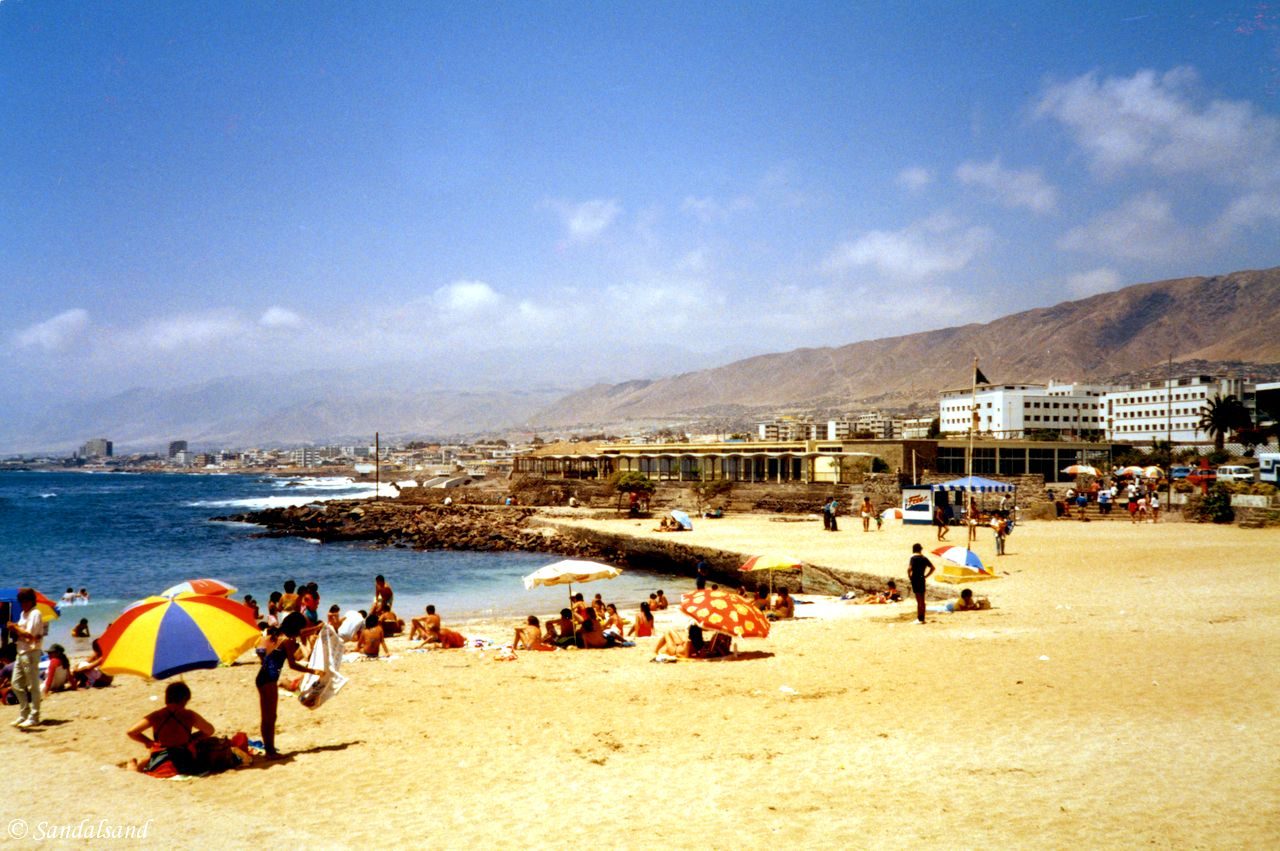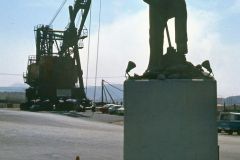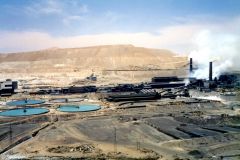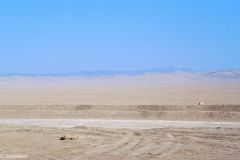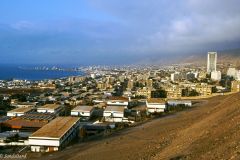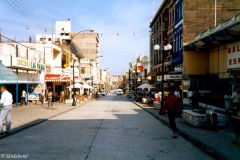In northern Chile we found peace and prosperity. After 36 hours on the train from Bolivia we had a belated arrival in a country very unlike its neighbours to the east and north. We went about with the usual money exchanging activity, and visited the world’s largest mine.
This article is part of a travelogue from of a five month journey in 1987-1988 to several countries in South America: Brazil, Peru, Ecuador, Bolivia, Chile.
(A remark on currency: 250 pesos (C$) to a dollar US, moving towards 260 later)
Sunday 10.01.1988, Calama
The train from La Paz, Bolivia arrived close to three in the morning and the four of us went into town to find a hotel.
- Residencial Capri. Calle Vivas; 1400 C$ (5.6 USD) for a double with bath in the corridor. Not the big thing and zero water in the morning and daytime. Slow service.
It felt lovely to lie down on a bed after rather uncomfortable vertical train seats. At the hotel they demanded payment right away and luckily (for them and us) they accepted dollars at a good rate. We exchanged more than for the night and had something for the coming day as well.
As there was no water we went hunting for another hotel, unfortunately without finding a suiting one. The tourist information office was closed and a young Argentinian exchanged some more cash. In the meantime Blake and Jane had found a better hotel and left us a message. We went over to them and checked into the same place.
- Residencial Splendid. Calle Ramirez no. 1960. 1600 C$ (6.4 USD) for a double without a private bath. Clean, quiet and nice with a lot of hot water, almost too hot. (Map)
Some Chilean girls going to Bolivia on vacation came up asking if we wanted to do some money exchanging. If? I was beginning to get afraid we would get stuck with our 40 bolivianos (18 USD). We exchanged them to pesos along with a few dollars at rates of 2.2 and 250 respectively.
We had a good dinner with good Chilean red and white wine together with Blake and Jane from Australia, Ossie and Tony from England and two Chilean engineers. It was very alright and interesting.
Monday 11.01.1988, Calama – Chuquicamata
This was an interesting Monday. We first went to the tourist information office and got a few brochures and tips on bus companies which operate on the Antofagasta route. We bought tickets with one of them (Flecha Dorada) for tomorrow morning for 700 C$ (2.8 USD).
After breakfast we took a collectivo with the two Australians and the British to the neighbouring town ofChuquicamata to see the world’s largest mine, at least in terms of production.
First we had lunch, cheap and good, on the Arco Iris restaurant inside Chuqui itself. Afterwards, by the mine, the tour started with a fifteen minute long video before we and some other tourists were taken around in the area on a bus. (“Voluntarily” we paid 150 for the fun; the money went to a social fund for crippled children – fair enough.)
The mine
In the mine they excavate copper and sulphate. The company, nationalised by Allende right before the coup, is still in the hands of the state. This is perhaps no wonder as it accounts for 40 % of the state’s revenue. The entire Chuqui is owned by the company; houses, shops and kindergartens. There are 9,000 employed by the mine.
The mine consists of two day pits. The largest is 600 metres deep and cut into layers, good for another 150 years. Huge excavators and trucks with tires 3.2 metres in diameter drive continuously 24 hours a day, year-round. Each day 450,000 tons of rock is blown up, of which 160 tons become pure copper. This we were told is a significant amount.
Pollution: The smoke from huge factory pipes and the result of other activities must create some damage even though our guide not quite convincingly tried to downplay it.
Calama seems modern and “civilised” very unlike Peru and Bolivia. Here they have good wine, lovely cold beer, real water on bottles, good ice-cream and the locals are well-dressed reflecting well-equipped stores. The prices are about the same as in Bolivia.
Tuesday 12.01.1988, Antofagasta
Everything is fine. Flecha’s luxury bus brought us to Antofagasta on the coast in less than three hours, with a cup of coffee for free (although with sugar). There was even more desert to see along the road.
Antofagasta is a modern semi-big town and lovely “civilised” after 2.5 months in the Andes Mountains.
- Residencial Paola. The actual residencial was full but the dueña brought us to the annex. 1200 (4.8 USD) for a double without bath. Clean and nice in a private home! Hot shower. Good breakfast for 100 extra.
.
We went to the tourist information office which was helpful with information and brochures. Later we took a bus up to some ruins which were rather uninteresting. It was strange to see how gradually poorer the houses became as we went higher up the hill, towards the desert.
Wednesday 13.01.1988, Antofagasta
It is strange how tired we get here in the lowlands. It has to be because of the “heavy” air.
I forgot to mention that we yesterday met an old man in the park. He spoke good English and talked about this and that, including politics. He was a bit worried about people around us, but like he said: “I’m too old to get beaten up”.
We exchanged more money in a liquor shop at a rate of 250.
Yesterday we were almost assaulted by eager restaurant people when we wanted to buy some lunch at the market. The prices were around 250-300 pesos (a dollar). Today we bought some food to carry (a lot of fine fruit) and went to the beach. On the way we met Blake and Jane again. This was the first time I’ve been called at on a South American street. It was fun to see them again.
The beach was small, quite crowded, and warm. We got a reddish tan and I was finally able to swim in the Pacific again.
Thursday 14.01.1988, Antofagasta – La Serena
Yesterday we bought ourselves bus tickets to La Serena for 3200 pesos (12.8 USD). Barrios was the only company with available seats on a morning bus. Most buses leave in the evening. Blake and Jane told us they had bargained the price down to 1700 so we will have to try that next time.
The trip took us 12.5 hours with coffee and a sandwich included, through more deserts and with a control against the transport of contaminated fruits to the south. At times the desert offered vivid colours, but it soon gave way to greener areas up the Copiapó valley.
At the station we met Blake and Jane again. They were going to Santiago on yet a night bus.
- Residencial El Loa. It was a nice place for 1,600 (6.4 USD) for the two of us. Clean and with breakfast for 150 extra.
Friday 15.01.1988, La Serena
We walked around in a pleasant town in colonial style. There were many shopping streets and as usual (until now) in Chile, nice weather.
We made a detour to Coquimbo (120p, ¼ h) which was ordinary.
Back in La Serena we purchased fruit and wine and had lunch in our room.
For dinner we had delicious fish on an, according to the South American Handbook, “unpretentious and excellent restaurant” – Club Social.
We thought we might go on to Vicuña this afternoon, and to Santiago tomorrow, but the temptation of spending another day on the beach was too big. So we will stay here another day.
Saturday 16.01.1988, La Serena
We did not make the bus to Vicuña from the bus terminal and used the opportunity to buy a ticket toSantiago for tomorrow morning at the Fenix Company for 1600 pesos (6.4 USD).
After this we found a collectivo stop for cars going to Vicuña. We paid 350 and arrived after an hour drive through a green valley with semi-green mountains around. We had fruit for lunch in the park after having seen the birthplace of the town’s big heroine, Gabriela Mistral – the Nobel prize winner in literature in 1945. The bus home cost us 270.
From La Serena we went to a beach called Peñuelas. There were some people and the clouds (haze) gave way to the sun after a while. The sea was a bit chillier than in Antofagasta and the seabed was kind of muddy.
We rounded the evening off with pizza and beer.
Read more
The next chapter: Santiago de Chile. We had some relaxing days in the capital of Chile. It was a wonderful city, much to see and with lovely summer weather.
Read the introduction to this journey
View a full screen map of the journey

